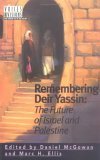Atrocities Jewish Deir Yassin Ellis

Remembering Deir Yassin: The Future of Israel and Palestine, by Marc H. Ellis . 1998
The Undeniable Slaughter of Arab Civilians by Jewish Soldiers
We hear a lot, in the media, about Poles and Jedwabne. We never hear about Jewish massacres of non-Jews. So let’s once hear it.
What actually happened at Deir Yassin on April 9, 1948? The ZOA (Zionist Organization of America) would have us believe that there had been no massacre and that all the civilian deaths had merely been the result of normal combat operations. Their revisionist tract, DEIR YASSIN: HISTORY OF A LIE, though featured positively in the American press (p. 3) is extensively refuted in this book.
FALSE EXCULPATIONS FOR THE MASSACRE
In fact, the collateral-deaths-in-combat revisionist case falls apart almost immediately. To begin with, the low death toll of the Jewish attackers (Irgun and Lehi guerillas) proves that they encountered very little resistance at Deir Yassin: “As it occurred, we are told, when a force of 120 untested troops with insufficient ammunition and inadequate weaponry successfully managed to storm fortified stone houses but who miraculously suffered only 5 percent casualties.” (pp. 2-3; see also p. 29). Moreover, accounts of Arab soldiers fighting at Deir Yassin are entirely secondary in origin (p. 20, 28).
When civilians are unintentionally hit by combat crossfire, one normally expects many more wounded than dead. But at Deir Yassin, it was exactly the opposite: 20, perhaps up to 50, wounded against 110 dead (p. 25). The implications are stark: “A systematic slaughter is powerfully indicated by this remarkable statistic alone. We would otherwise have to believe a group of ill-trained and poorly equipped fighters repeatedly scored a miraculously high rate of lethal wounds on persons they say they did not intend to hit.” (p. 25).
The number of fatalities is also telling: “One hundred ten dead, predominantly civilians, in a single village battle is a huge red flag that there was deliberate killing. Ground combat in a peasant village, even with modern weapons, does not usually cause that high a number of civilian deaths…In Vietnam, a civilian death figure of about 20 in a rural village battle was considered ‘abnormally high,’ requiring investigation by a command-level officer…Deir Yassin’s death toll of 110 was thus as much as 5 times the number of civilian deaths considered disturbingly excessive in bloodier village combat (helicopter gunships, artillery barrages, search and destroy, etc.) where much greater firepower was typically brought to bear against flimsier dwellings.” (pp. 22-23). Such things as women fighting, men disguised as women, fake surrenders, etc., are timeless features of war and do not alter the foregoing conclusions (p. 27). To make the case even stronger, there is no evidence of mortar shells being used against Deir Yassin (p. 49) or of any especially-destructive weapons employed (p. 27).
Numerous Jewish eyewitnesses and Jewish investigators recognize the fact of the Deir Yassin massacre (p. 1, 3, 4, 13-14, 16, 18, 48, 73). In fact, the Jewish attackers themselves admitted committing the massacre (pp. 72-73) and, in a boast, inflated the death toll from 110 to the oft-quoted 254 (p. 65).
AN ISRAELI COVERUP OF THE DEIR YASSIN MASSACRE?
The Israeli government refuses to release photos of the Deir Yassin victims (p. 12). If they support a collateral-deaths-in-combat explanation, one wonders why.
In summarizing how the civilians of Deir Yassin died, the authors conclude: “Most were killed by close range gunfire, some by stabbing, a few in combat, and some while fleeing. Most of the victims of the massacre, as the burial chief later lamented, were old men, women, and children, who died with no weapon in their hands. There was not combat chaos or circumstances necessitating their deaths, despite the early fighting. They were intentionally murdered.” (p. 64). McGowan and Hogan also have some choice words: “Describing the Deir Yassin massacre as false, exaggerated, or in dispute, is to engage in the same impudence as Holocaust Revisionism. The same applies to alleging a false origin of the reports of massacre.” (pp. 72-73). “The slaughter is as immune to historical doubt as are such atrocities as the My Lai massacre, the Bataan Death March, and the Holocaust.” (p. 2).
TIT FOR TAT
McGowan and Hogan believe that the Deir Yassin massacre was motivated by the desire for collective revenge against Arabs for earlier massacres of Jews (p. 37, 48). (The informed reader who wants to compare Deir Yassin and Jedwabne may recount the fact that Polish participation in the Jedwabne massacre, to the extent that it was consensual under German command, had been motivated by the desire for collective revenge against Jews for the earlier Jewish-Soviet collaboration against Poles).
To see a series of truncated reviews in a Category click on that Category:
- All reviews
- Anti-Christian Tendencies
- Anti-Polish Trends
- Censorship on Poles and Jews
- Communization of Poland
- Cultural Marxism
- German Guilt Dilution
- Holocaust Industry
- Interwar Polish-Jewish Relations
- Jewish Collaboration
- Jewish Economic Dominance
- Jews Antagonize Poland
- Jews Not Faultless
- Jews' Holocaust Dominates
- Jews' Holocaust Non-Special
- Nazi Crimes and Communist Crimes Were Equal
- Opinion-Forming Anti-Polonism
- Pogrom Mongering
- Poland in World War II
- Polish Jew-Rescue Ingratitude
- Polish Nationalism
- Polish Non-Complicity
- Polish-Ukrainian Relations
- Polokaust
- Premodern Poland
- Recent Polish-Jewish Relations
- The Decadent West
- The Jew as Other
- Understanding Nazi Germany
- Why Jews a "Problem"
- Zydokomuna